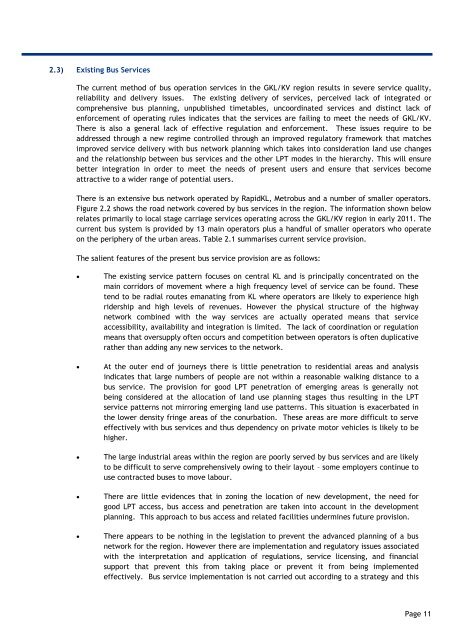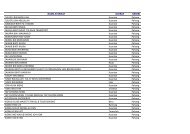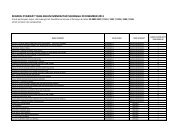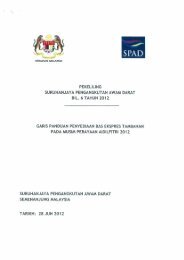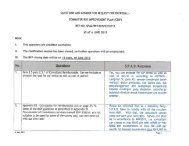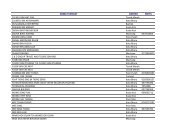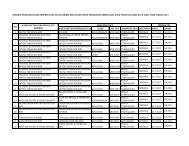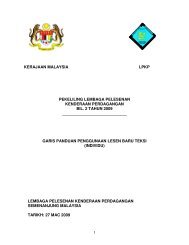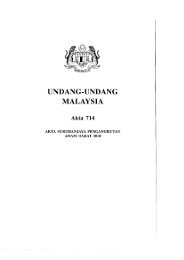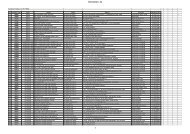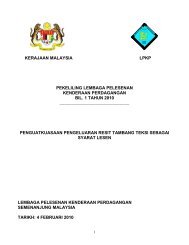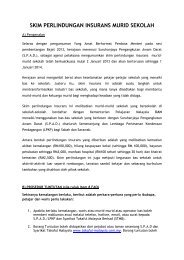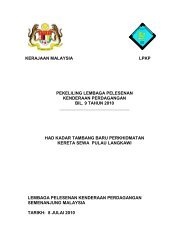Contents - SPAD
Contents - SPAD
Contents - SPAD
Create successful ePaper yourself
Turn your PDF publications into a flip-book with our unique Google optimized e-Paper software.
2.3) Existing Bus Services<br />
The current method of bus operation services in the GKL/KV region results in severe service quality,<br />
reliability and delivery issues. The existing delivery of services, perceived lack of integrated or<br />
comprehensive bus planning, unpublished timetables, uncoordinated services and distinct lack of<br />
enforcement of operating rules indicates that the services are failing to meet the needs of GKL/KV.<br />
There is also a general lack of effective regulation and enforcement. These issues require to be<br />
addressed through a new regime controlled through an improved regulatory framework that matches<br />
improved service delivery with bus network planning which takes into consideration land use changes<br />
and the relationship between bus services and the other LPT modes in the hierarchy. This will ensure<br />
better integration in order to meet the needs of present users and ensure that services become<br />
attractive to a wider range of potential users.<br />
There is an extensive bus network operated by RapidKL, Metrobus and a number of smaller operators.<br />
Figure 2.2 shows the road network covered by bus services in the region. The information shown below<br />
relates primarily to local stage carriage services operating across the GKL/KV region in early 2011. The<br />
current bus system is provided by 13 main operators plus a handful of smaller operators who operate<br />
on the periphery of the urban areas. Table 2.1 summarises current service provision.<br />
The salient features of the present bus service provision are as follows:<br />
<br />
<br />
<br />
<br />
<br />
The existing service pattern focuses on central KL and is principally concentrated on the<br />
main corridors of movement where a high frequency level of service can be found. These<br />
tend to be radial routes emanating from KL where operators are likely to experience high<br />
ridership and high levels of revenues. However the physical structure of the highway<br />
network combined with the way services are actually operated means that service<br />
accessibility, availability and integration is limited. The lack of coordination or regulation<br />
means that oversupply often occurs and competition between operators is often duplicative<br />
rather than adding any new services to the network.<br />
At the outer end of journeys there is little penetration to residential areas and analysis<br />
indicates that large numbers of people are not within a reasonable walking distance to a<br />
bus service. The provision for good LPT penetration of emerging areas is generally not<br />
being considered at the allocation of land use planning stages thus resulting in the LPT<br />
service patterns not mirroring emerging land use patterns. This situation is exacerbated in<br />
the lower density fringe areas of the conurbation. These areas are more difficult to serve<br />
effectively with bus services and thus dependency on private motor vehicles is likely to be<br />
higher.<br />
The large industrial areas within the region are poorly served by bus services and are likely<br />
to be difficult to serve comprehensively owing to their layout – some employers continue to<br />
use contracted buses to move labour.<br />
There are little evidences that in zoning the location of new development, the need for<br />
good LPT access, bus access and penetration are taken into account in the development<br />
planning. This approach to bus access and related facilities undermines future provision.<br />
There appears to be nothing in the legislation to prevent the advanced planning of a bus<br />
network for the region. However there are implementation and regulatory issues associated<br />
with the interpretation and application of regulations, service licensing, and financial<br />
support that prevent this from taking place or prevent it from being implemented<br />
effectively. Bus service implementation is not carried out according to a strategy and this<br />
Page 11


